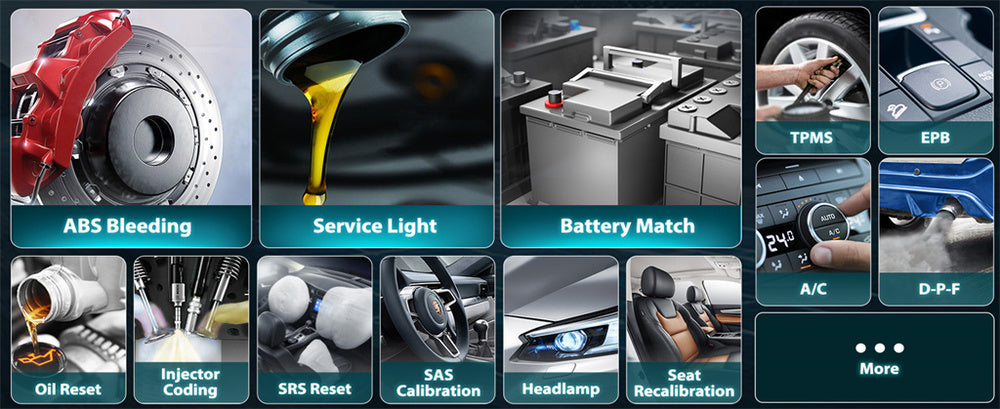If your vehicle's brakes still feel soft or spongy after servicing them, the cause could be the air that has entered its ABS (Anti-lock Braking System) module after a brake job or when air enters your master cylinder.
Bleeding the lines alone might not resolve this problem, as air trapped in an ABS module requires specific procedures involving a scan tool to activate it during bleeding.
However, you don't need to buy expensive tools or go to a professional shop just for this task—we will examine cost-effective tools and practical techniques for activating the ABS bleed procedure, along with tips for restoring your brakes to their former glory.
Reasons Why ABS Systems Require Bleeding Procedures

An ABS is designed to prevent your wheels from locking up during hard braking by employing sensors and valves to regulate brake pressure when it detects potential skidding incidents. When bleeding ABS systems, however, air can get trapped inside its internal passages and valves, requiring special procedures to unclog.
However, unlike brake lines, which can be easily bled with traditional methods, the ABS module requires activation to open its valves and force air out. Without this activation, even after regular bleeding, air could remain trapped within the system, leading to soft or nonresponsive brakes. As a result, a scan tool is usually necessary to engage and activate the ABS system and properly bleed your brakes.
Signs that It Is Time to Bleed Your ABS Module
If air is trapped within your ABS module, specific symptoms could manifest even after performing a standard brake bleed.
One telltale sign is a soft or "mushy" brake pedal when pressed or repeated pumping of the pedal; another may be that your brakes firm up after repeatedly pumping them; it might also take longer for your vehicle to stop or require more significant pressure on its pedal to be effective in preventing.
Sometimes, the ABS warning light on your dashboard might illuminate to indicate an issue with the system. If any such problems surface after working on your brakes, it's likely that your ABS module needs to be bled.
Affordable Scan Tools for ABS Bleeding
Professional shops may use expensive scan tools for ABS bleeding. Still, you can also find more budget-friendly versions from Foxwell that provide similar functionality - these budget-friendly models from Foxwell would make an excellent addition to DIY mechanics:
Foxwell NT809: For those searching for more advanced features, the Foxwell NT809 provides comprehensive system coverage—including ABS—across various vehicles and can handle both bleeding and more complex tasks such as oil resets or battery configuration. With its user-friendly interface and advanced diagnostic capabilities, this tool makes ideal vehicle maintenance tasks possible.
Foxwell NT650 Elite:This tool balances affordability and functionality, supporting ABS bleeding and other necessary vehicle maintenance procedures like electronic parking brake resets and service light resets. Ideal for those who perform both ABS procedures and ongoing vehicle care services, this cost-effective option makes an affordable addition to your toolbox.
These tools are easy to use and compatible with various vehicle models, making them excellent choices for activating ABS bleed functions without spending a great deal.
Manual Methods for Bleeding ABS Brakes Without a Scan Tool
Even without access to a scan tool, manual methods exist to activate and purge air from an ABS and eliminate trapped air. One such approach involves driving on low-traction surfaces and performing controlled hard stops; this can activate the ABS by simulating wheel lockup and engaging its pump and valves, triggering wheel lockup to trigger its activation and remove any trapped air that remains.
An alternative strategy involves repeated hard braking in a controlled, safe environment, such as an empty parking lot. Although this method may be less precise, it may cause your ABS to activate and force air out of its module, making the bleed-back more straightforward afterward.
Although manual methods might only sometimes work for some vehicles, they provide an inexpensive first step before resorting to more costly tools or professional assistance.
Step-by-Step Guide for an ABS Bleed Procedure
The process for bleeding an ABS should be straightforward whether using a scan tool or manual methods; here's a step-by-step guide that should make things simpler:
- Lift Your Vehicle: Before beginning, lift your vehicle safely to access its brake calipers and lines.
- Prepare the Bleeders: Attach speed or pressure bleeders to the brake lines, starting from the wheel farthest from the master cylinder (usually the rear passenger side).
- Engage the ABS System: If you own a scan tool, follow its instructions to activate the ABS bleed feature and run through its cycles before opening all valves to allow air from your module.
- Bleed the Brakes: Once your ABS is active, bleed your brake lines using either steady pedal pressure or a pressure bleeder to maintain consistent pressure levels in each line.
After bleeding all brakes, carefully evaluate how firm or soft the pedal feels. If it still seems soft after several attempts at bleeding air out, repeat this process until all air has been eliminated from the pedal.
Troubleshooting: Why Your Brakes Still Feel Soft After Bleeding
If your brakes feel soft after performing an ABS bleed, several potential causes could be at play. One possibility is that not all air was effectively expelled during the bleeding process; perhaps some air remains trapped within your system because your bleeding was interrupted or not completed correctly.
Old or contaminated brake fluid could also be to blame. Maintaining optimal brake performance relies on using fresh, high-quality fluid. When old fluid has absorbed moisture, it can significantly decrease efficiency while giving an uneven pedal feel and creating an unsafe stopping experience.
The master cylinder itself could be the finalizing factor in our investigation. When worn or damaged, master cylinders may fail to provide enough pressure for brake system operation, leading to soft pedaling. If this is the case, replacing the master cylinder may be necessary.

How to Select the Appropriate Brake Fluid for ABS Systems
When bleeding an ABS system, the appropriate type of brake fluid must be used—typically, either DOT 4 or 5.1 fluid is required, depending on the vehicle type.
DOT 4 brake fluid is commonly found in vehicles equipped with ABS. Although its boiling point is high, moisture absorbs into it over time and affects braking performance. High-performance or heavy-duty vehicles would benefit more from using DOT 5.1 fluid with even higher boiling point levels; make sure to use fresh fluid from an unopened bottle to ensure optimal performance and prevent moisture contamination.
Conclusion
Bleeding an ABS system doesn't need to be complicated or expensive; all it requires are the appropriate tools, such as Foxwell NT809, or NT650 Elite scan tools, to activate and perform proper brake bleed. DIY mechanics will appreciate these budget-friendly scan tools, which offer not just ABS bleeding capabilities but a range of diagnostic tasks as well.
If you prefer manual methods over purchasing a scan tool, controlled hard stops on low-traction surfaces may activate ABS and push air out of the system, activating ABS. Following proper procedures ensures your brakes will work safely and efficiently.
FAQs
What is ABS bleeding?
ABS bleeding is the process of removing air from the Anti-lock Braking System (ABS) to ensure proper brake function. It involves activating the ABS pump and valves to push air out of the ABS module, which can get trapped during brake system repairs.
How do you bleed an ABS sensor?
You don't typically "bleed" an ABS sensor, as it's an electronic component that detects wheel speed. However, to bleed the ABS system, you need to activate the ABS module (usually with a scan tool) so that the internal pump and valves cycle, allowing air to be expelled during the brake bleed process.
What tool is required to bleed the ABS system?
A scan tool that can activate the ABS module, such as the Foxwell NT809, or Foxwell NT650 Elite, is commonly used to bleed the ABS system. These tools allow you to engage the ABS pump and valves to ensure proper bleeding.




Leave a comment
This site is protected by hCaptcha and the hCaptcha Privacy Policy and Terms of Service apply.